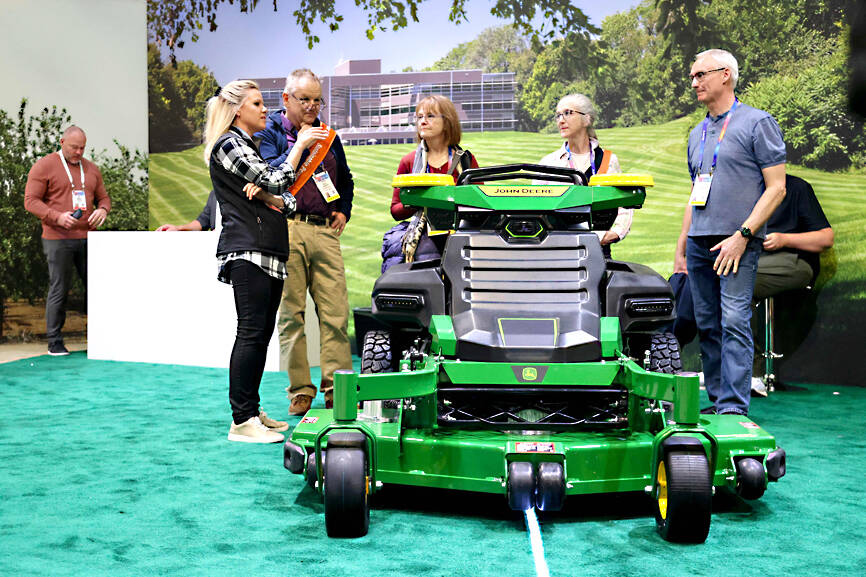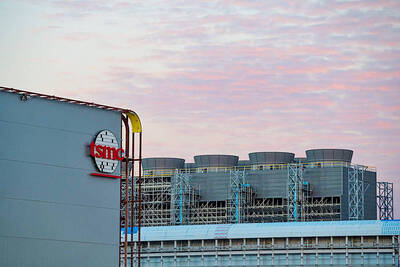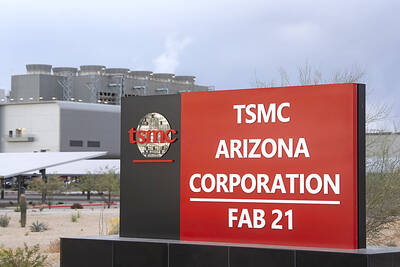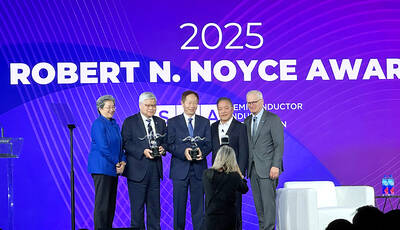Today’s robots perform safety checks at industrial plants, conduct quality control in manufacturing and are even starting to keep hospital patients company.
However, soon — perhaps very soon — these increasingly humanlike machines would handle more sophisticated tasks, freeing up people while raising complex questions about the roles of artificial intelligence (AI) that are gaining attention.
At a panel hosted by the American Association of Retired Persons (AARP) at this week’s Consumer Electronics Show (CES), experts described the next five years as a period in which robots transition primarily from industrial sites to service settings, helping to address a worsening healthcare labor crunch.

Photo: AFP
Seeing robotics in places like theme parks or universities “will lead to the companion robot probably at the end of the decade,” Boston Dynamics chief strategy officer Marc Theermann said.
Cris Gardner, a vice president in future casting at AARP, predicted robots would provide emotional support as they enter homes and assist with daily tasks.
People “will own a generalized humanoid robot the way they would own a car,” she said.
Dystopian prophesies of a robot-centered future have long featured in the public imagination. However, recent breakthroughs in generative AI have given more credibility to predictions of billions of humanoid robots in everyday life.
The centrality of robots in the coming years is “widely underappreciated,” said a report from Abundance 360, a conference and education venture led by entrepreneur Peter Diamandis.
Robots could enable an “era of unprecedented abundance,” lowering costs while freeing humans “to focus on creative and fulfilling pursuits,” it said.
However, the analysis also identified nine sectors facing potential job displacement, including manufacturing, eldercare, agriculture, education and surgery.
“The speed at which multimodal generative AI and humanoid robot development is progressing, paired with the lack of public discourse on this subject, indicates that there will be significant job disruption and societal upheaval,” it said.
Disputes over automation have been a recurring factor in labor negotiations, most recently involving US dockworkers, who reached a tentative agreement with a shippers’ group, averting a strike.
The International Longshoremen’s Association permitted ports to add semi-autonomous cranes only if more workers are hired, the Wall Street Journal reported.
At CES, companies described robots as performing tasks that humans either should not do because they are dangerous, or do not want to do because they are grueling, tedious or unpleasant.
Hong Kong company R2C2 showcased industrial robots that can perform functions such as inspections at power plants and technician work on trains, according to the company’s founder and chief executive San Wong.
Working on trains involves “lots of grease everywhere, and it’s dirty and hot” so turnover is high, Wong said.
Vehicle and equipment maker Oshkosh has used automation to phase out high-burnout jobs such as the finishing work on firetrucks, which requires workers to wear a mask and often leads to shoulder and elbow problems, chief executive John Pfeifer said.
Those workers have been shifted to other assembly line work, such as welding.
While these jobs are currently safe, they might “one day” be automated, Pfeifer said.
“This has been the evolution of the economy for 250 years,” he said. “People move into more productive ways to help the economy grow.”
At CES, US agriculture machinery giant John Deere showcased autonomous vehicles developed partly in response to persistent farm labor shortages.
Automation allows farmers to focus on more challenging tasks, such as managing grain movement from a field to a storage area, said Deanna Kovar, president of Deere’s worldwide agriculture and turf division.
“We need to continue to make sure we’re evolving the skill sets of our employees, of our customers, so that they can take advantage of the technologies and not see them as a threat,” she said.
The aging US population points to a significant labor gap for caring for the next generation of elderly people, Gardner said.
“The demand is going to be enormous, it can’t be covered by human beings,” said Gardner, who views improved robotics as key to enabling older people to stay independent for longer.

Shiina Ito has had fewer Chinese customers at her Tokyo jewelry shop since Beijing issued a travel warning in the wake of a diplomatic spat, but she said she was not concerned. A souring of Tokyo-Beijing relations this month, following remarks by Japanese Prime Minister Sanae Takaichi about Taiwan, has fueled concerns about the impact on the ritzy boutiques, noodle joints and hotels where holidaymakers spend their cash. However, businesses in Tokyo largely shrugged off any anxiety. “Since there are fewer Chinese customers, it’s become a bit easier for Japanese shoppers to visit, so our sales haven’t really dropped,” Ito

The number of Taiwanese working in the US rose to a record high of 137,000 last year, driven largely by Taiwan Semiconductor Manufacturing Co’s (TSMC, 台積電) rapid overseas expansion, according to government data released yesterday. A total of 666,000 Taiwanese nationals were employed abroad last year, an increase of 45,000 from 2023 and the highest level since the COVID-19 pandemic, data from the Directorate-General of Budget, Accounting and Statistics (DGBAS) showed. Overseas employment had steadily increased between 2009 and 2019, peaking at 739,000, before plunging to 319,000 in 2021 amid US-China trade tensions, global supply chain shifts, reshoring by Taiwanese companies and

Taiwan Semiconductor Manufacturing Co (TSMC, 台積電) received about NT$147 billion (US$4.71 billion) in subsidies from the US, Japanese, German and Chinese governments over the past two years for its global expansion. Financial data compiled by the world’s largest contract chipmaker showed the company secured NT$4.77 billion in subsidies from the governments in the third quarter, bringing the total for the first three quarters of the year to about NT$71.9 billion. Along with the NT$75.16 billion in financial aid TSMC received last year, the chipmaker obtained NT$147 billion in subsidies in almost two years, the data showed. The subsidies received by its subsidiaries —

Taiwan Semiconductor Manufacturing Co (TSMC) Chairman C.C. Wei (魏哲家) and the company’s former chairman, Mark Liu (劉德音), both received the Robert N. Noyce Award -- the semiconductor industry’s highest honor -- in San Jose, California, on Thursday (local time). Speaking at the award event, Liu, who retired last year, expressed gratitude to his wife, his dissertation advisor at the University of California, Berkeley, his supervisors at AT&T Bell Laboratories -- where he worked on optical fiber communication systems before joining TSMC, TSMC partners, and industry colleagues. Liu said that working alongside TSMC